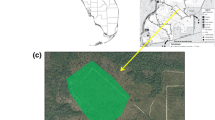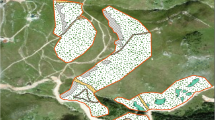Summary
ThreeAthalia sawflies,A. japonica, A. rosae andA. infumata, feeding on cruciferous plants, coexist in Japan. However, it is not known what ecological strategies they use and what environmental factors are crucial to such strategies. I attempted to explain these questions by examining the relationship between the spatio-temporal distribution patterns of threeAthalia sawflies and their habitats in three districts (Lowland, Intermediate and Mountain).
The three sawflies have different spatio-temporal distribution patterns, though they usually used common cruciferous plants.A. japonica was abundant in spring and autumn but disappeared during summer in all the districts. In the Lowland, populations ofA. rosae andA. infumata, like that ofA. japonica, crashed in summer. HoweverA. rosae occurred mainly in summer in the Intermediate and Mountain. AlthoughA. infumata occurred in the same seasons asA. rosae in all districts, population levels ofA. infumata were always lower than those ofA. rosae.
The crucial factors controlling their population patterns were the availability of host plants and temperature. Population crashes ofA. rosae andA. infumata were due to food depletion, and those ofA. japonica were due to heat stress. On the other hand, their population patterns may be interpreted as phenological synchronization with their original host plants, though they all existed on common cruciferous plants.
The three sawflies may have evolved different strategies to escape from unfavorable habitat conditions. Such strategies are speculated to be summer diapause inA. japonica, long distance migration inA. rosae, and local dispersal inA. infumata.
Similar content being viewed by others
References
Abe, M. (1988) A biosystematic study of the genusAthalia Leach of Japan (Hymenoptera: Tenthredinidae).ESAKIA 26: 91–131.
Benson, R. B. (1962) A revision of the Athaliini (Hymenoptera: Tenthredinidae).Bull. Brit. Mus. (Nat. Hist.) Ent. 11: 335–382
Dingle, H (ed) (1978)Evolution of insect migration and diapause. Springer-Verlag, Berlin.
Ehrnlich, P. R., R. R. White, M. C. Singer, S. W. McKechnie and L. E. Gilbert (1975) Chekerspot butterflies: an historical perspective.Science 188: 221–228.
Hairston, N. G., F. E. Smith and L. B. Slobodkin (1960) Community structure, population control, and competition.Am. Nat. 94: 421–425.
Hirano, K. (1985) Population dynamics of a phytophagous lady-beetle,Henosepilachna vigitioctopunctata (Fabricius), living in spatio-temporally heterogeneous habitats. I. Estimation of adult population parameters based on a capture-recapture census.Res. Popul. Ecol. 27: 159–170.
Iwao, S. (1971) Dynamics of numbers of a phytophagous lady-beetle,Epilachna vigintioctomaculata, living in patchily distributed habitats. 129–147. In P. J. Den Boer and G. R. Gradwell (eds)Dynamics of Populations. Proc. Adv. Study Inst. on ‘Dynamics of numbers in populations’. Pudoc, Wageningen.
Kitamura, S. and G. Murata (1963)Coloured Illustrations of Herbaceous Plants of Japan (Choripetalae). Hoikusha, Osaka, Japan (in Japanese).
Lawton, J. H. and D. R. Strong, Jr. (1981) Community patterns and competition in folivorous insects.Am. Nat. 118: 317–338.
May, R. M. (1974) Ecosystem patterns in randomly fluctuating environments. 1–50. In S. A. Levin (ed)Progress in Theoretical Biology 3. Academic Press, New York.
Nakamura, K. and T. Ohgushi (1979) Studies on the population dynamics of a thistle-feeding lady beetle,Henosepilachna pustulosa (Kono) in a cool temperate climax forest. I. The estimation of adult population parameters by the marking, release and recapture method.Res. Popul. Ecol. 20:297–314.
Ohgushi, T. and H. Sawada (1981) The dynamics of natural populations of a phytophagous lady beetle,Henosepilachna pustulosa (Kono) under different habitat conditions. I. Comparison of adult population parameters among local populations in relation to habitat stability.Res. Popul. Ecol. 23: 94–115.
Ohsaki, N. (1980) Comparative population studies of threePieris butterflies,P. rapae, P. melete andP. napi, living in the same area. II. Utilization of patchy habitats by adults through migratory and nonmigratory movement.Res. Popul. Ecol. 22: 163–183.
Southwood, T. R. E. (1977) Habitat, the templet for ecological strategies?J. Anim. Ecol. 46: 337–365.
Strong, D. R., J. H. Lawton and T. R. E. Southwood (1984)Insects on Plants. Harvard University Press, Cambridge.
Author information
Authors and Affiliations
Rights and permissions
About this article
Cite this article
Nagasaka, K. Crucial factors determining the spatio-temporal distribution patterns of threeAthalia sawflies feeding on common cruciferous plants. Res Popul Ecol 33, 115–128 (1991). https://doi.org/10.1007/BF02514578
Issue Date:
DOI: https://doi.org/10.1007/BF02514578




